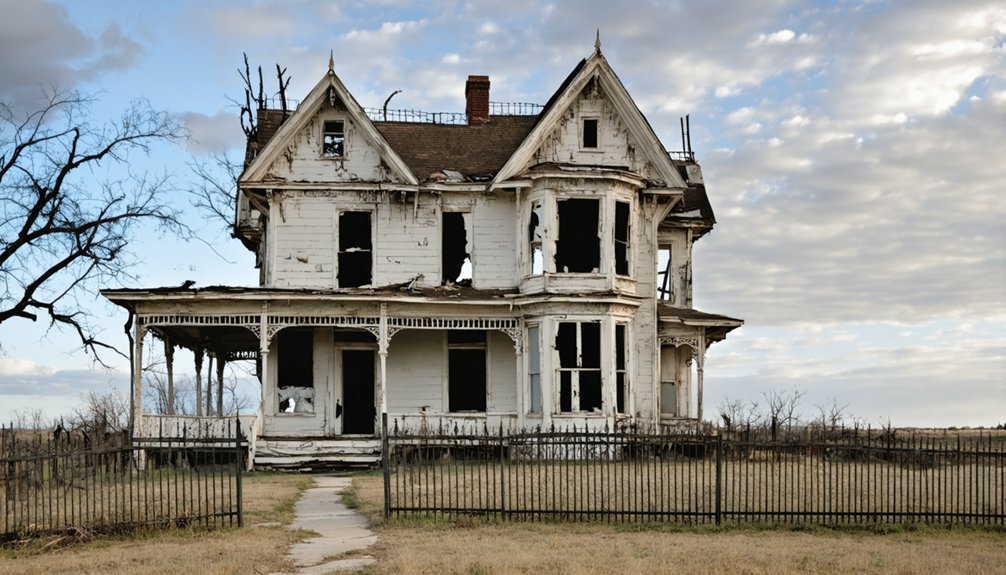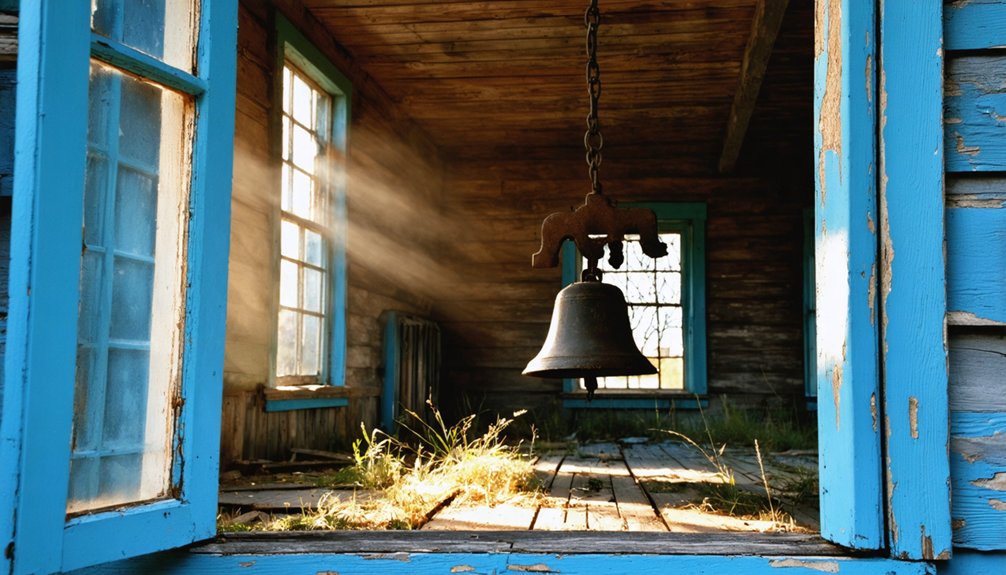You’ll find Kittie (aka Kittie West) among Texas’s 511 documented ghost towns, established in the early 1900s by developer George West to honor his wife. The settlement struggled against harsh desert conditions, with temperatures exceeding 100°F and minimal rainfall of 6-20 inches annually. After West’s death in 1926, development stalled, and the population dwindled. Today, this forgotten community holds untold stories of pioneering women and ambitious frontier dreams.
Key Takeaways
- Kittie was established in early 1900s by George West, who named the Texas town after his wife.
- The town’s decline began after George West’s death in 1926, leading to incomplete development projects and infrastructure.
- Harsh desert climate, lack of rainfall, and geographic isolation contributed significantly to Kittie’s eventual abandonment.
- Kittie is one of 511 documented ghost towns in Texas, representing the broader pattern of rural community decline.
- Women played crucial roles in Kittie’s early development, though their contributions are primarily preserved through historical documentation.
The Legacy of George West’s Wife

When George West established the town of Kittie in the early 1900s, he chose to honor his wife by immortalizing her name in this Live Oak County settlement.
This symbolic naming reflected a common practice you’ll find throughout Texas history, where developers left their personal legacy through family-inspired town names.
While her direct involvement in town affairs isn’t well-documented, Mrs. West’s name became permanently woven into the region’s cultural fabric.
Though her role remains unclear, Mrs. West’s legacy endures through the town that once bore her name.
Similar to modern-day Valentine, Texas which was established in 1882, many small towns founded during this era have seen their populations dwindle to near ghost town status.
You can trace this connection through historical records and local archives, even though the town itself eventually faded into ghost town status.
Like the historic buildings of Alpine, many early Texas towns faced devastating fires that challenged their survival and development.
The name “Kittie” stands as a tribute to the personal dimensions of early Texas development, preserving the memory of both the West family and their aspirations for this once-promising settlement.
From Promising Plans to Ghost Town Status
Despite its promising beginnings in the early 1900s, Kittie West’s path toward ghost town status started with the death of its primary developer in 1926. The developer’s ambitious vision and early investments had sparked community aspirations for a thriving settlement in Live Oak County, but these dreams unraveled quickly after his passing.
You’ll find that the town’s early challenges multiplied as development projects stalled and crucial infrastructure went unfinished. Without strong leadership or continued investment, Kittie West couldn’t attract the residents and businesses needed to sustain growth. Like the town of Styles, which saw its population plummet from 75 in 1925 to near abandonment, Kittie West experienced a similar devastating decline. Similar to how extreme weather events forced many Texas settlements into abandonment, the harsh climate took its toll on the remaining residents.
The absence of critical railroad connections further isolated the settlement, and gradually, people drifted away to more prosperous areas. Buildings fell into disrepair, services shut down, and the once-promising town faded into another Texas ghost town.
Desert Climate and Geographic Challenges
The harsh desert climate of Kittie added considerable strain to the town’s survival challenges. You’d face summer temperatures soaring past 100°F, with only minimal relief during the night when they’d drop below 70°F.
Desert adaptation strategies became essential as you’d battle both intense heat and prolonged drought periods, broken only by brief monsoonal thunderstorms between early summer and mid-autumn. Severe thunderstorms posed significant risks to the sparse population during these periods.
The surrounding Sierra Madre Oriental Mountains created additional climate resilience challenges, blocking moisture and forming a rain shadow effect that left you with mere 6-20 inches of annual rainfall. The region’s climate resembled the Trans-Pecos Desert region, characterized by extremely dry conditions and limited precipitation.
You’d contend with strong winds whipping through the basin and range landscape, stirring up dust storms and shifting sand dunes. The mountainous terrain’s internal drainage patterns formed salt flats, further complicating agriculture and settlement efforts.
Architectural Remnants and Historical Sites
Standing as silent witnesses to Kittie’s bygone era, weathered wood-frame structures from the early 1900s dot the West Texas landscape, offering glimpses into the town’s founding period.
You’ll find these architectural remnants sharing similar characteristics with other ghost towns along Texas Highway 67, though Kittie’s structures are significantly fewer and more deteriorated.
The town’s architectural significance stems from its connection to George West, whose wife inspired its name. The town’s development came to an abrupt halt when the developer died in 1926.
Like the Old Alton Bridge, which serves as the last remaining structure of another Texas ghost town, these architectural elements provide tangible links to the region’s past.
While you won’t find officially designated landmarks here, the remaining foundational ruins and simple wooden buildings reflect the practical frontier design of early 20th-century rural Texas.
Preservation challenges abound as these structures face ongoing threats from harsh desert conditions, vandalism, and neglect, with no formal conservation efforts in place to protect these fragile pieces of regional history.
Life After the 1926 Developer’s Death
When the town’s primary developer died unexpectedly in 1926, Kittie West’s growth came to an abrupt halt.
You’d have witnessed the immediate economic stagnation as planned investments evaporated and construction projects ground to a standstill. Local businesses, once thriving from the developer’s patronage, couldn’t sustain their operations without essential financing.
Despite the community’s resilience, you’d have seen the town’s expansion plans crumble as property sales dried up and outside investors retreated.
The developer’s death created a ripple effect that touched every aspect of local commerce. Construction sites stood abandoned, and workers left to seek opportunities elsewhere.
The promising vision of a bustling Texas town faded as businesses shuttered their doors and families relocated, marking the beginning of Kittie West’s decline into obscurity.
Cultural Impact on Texas Rural History
When you examine Kittie West’s cultural legacy, you’ll find it represents the countless rural Texas communities that gradually lost their identity as residents migrated to larger towns and cities.
Like many of the 511 ghost towns documented across Texas, Kittie West exemplifies the widespread abandonment of rural settlements throughout the state’s history.
Similar to the stone structures that remain at the Cisco Zoo, these abandoned places serve as physical reminders of once-thriving communities.
You can trace how the town’s decline affected family bonds and community traditions that had been established by pioneering women settlers who helped shape early Texas frontier life.
The absence of Kittie West’s once-vibrant community gatherings and social networks mirrors a broader pattern of cultural erosion that occurred throughout rural Texas during the early to mid-twentieth century.
Rural Community Identity Loss
Throughout Texas’s rural history, the gradual disappearance of small towns like Kittie West represents more than just physical abandonment – it signals the erosion of deeply rooted community identities that once defined the state’s cultural landscape.
When you look at these vanishing communities, you’ll find that each lost resident chips away at the community cohesion that once bound neighbors together through shared traditions and daily life. What remains is often just a cultural memory preserved in cemetery plots and historical markers.
You can trace this identity loss to dramatic economic shifts, from railroad reroutings to the rise of highways that bypassed these rural settlements.
While local historical societies work to maintain connections to the past, the absence of living, breathing community life means you’re witnessing the slow fade of authentic rural Texas culture that once flourished in places like Kittie West.
Women’s Historical Settlement Role
The rich tapestry of Texas’s rural heritage would be incomplete without recognizing the profound influence of women who shaped these settlements from the ground up. Women homesteaders demonstrated remarkable resilience, with nearly 1,500 filing land claims between 1845-1898 in their pursuit of economic independence.
- Apache and Comanche women served as crucial diplomatic bridges, negotiating peace treaties and establishing trade networks with Spanish settlers.
- Mexican American women maintained mission settlements through healing practices and essential domestic industries.
- Female landowners transformed frontier territories into sustainable communities through agriculture and ranching.
- Women entrepreneurs operated as traders, vendors, and skilled craftspeople, contributing considerably to local rural economies.
You’ll find their legacy embedded in every aspect of Texas’s rural development, from Indigenous diplomatic relations to homestead cultivation and community building.
Frequently Asked Questions
Are There Any Ghost Stories or Paranormal Activities Reported in Kittie?
You won’t find documented ghost sightings or paranormal investigations in Kittie West. While it’s a genuine Texas ghost town, there’s no credible evidence of supernatural activity in this Live Oak County settlement.
What Was the Peak Population of Kittie During Its Most Prosperous Years?
While 90% of Texas ghost towns lack exact population statistics, you’ll find economic factors suggest Kittie West’s peak was likely under 200 residents during its brief prosperous period before decline.
Can Visitors Legally Explore and Photograph the Remaining Structures Today?
You’ll need property owner permission due to exploration restrictions, but you can photograph visible structures from public roads. Follow local photography guidelines to avoid trespassing violations in this private area.
Were There Any Notable Crimes or Significant Events Besides the Developer’s Death?
You won’t find notorious incidents or local legends here – historical records show no major crimes. Beyond the developer’s 1926 death, the town’s story is mainly about economic decline and gradual abandonment.
Did Any Famous People or Historical Figures Ever Visit Kittie?
You won’t find records of any famous visitors or historically significant figures in Kittie’s past. The town’s brief existence and limited documentation show it never attracted prominent personalities to its streets.
References
- https://www.youtube.com/watch?v=q5wnpQpgOzQ
- https://www.youtube.com/watch?v=lEiWo0GlPuI
- https://en.wikipedia.org/wiki/List_of_ghost_towns_in_Texas
- https://twodifferentgirls.com/2012/04/29/a-ghost-town-thats-not-quite-dead-crappy-places-to-be-from/
- https://www.texasescapes.com/SouthTexasTowns/Kittie-Texas.htm
- https://www.texasescapes.com/TOWNS/Texas-Ghost-Towns-3-Hill-Country.htm
- https://www.youtube.com/watch?v=6u47HvHWZXM
- https://www.expressnews.com/news/houston-weather/article/texas-ghost-towns-extreme-weather-hurricanes-19874031.php
- https://authentictexas.com/texas-ghost-towns/
- https://www.legendsofamerica.com/tx-ghosttowns/



